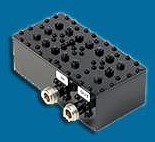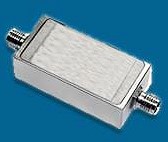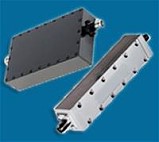|

Sam Benzacar of Anatech Electronics, an RF and microwave filter company, has published
his October 2022 newsletter that features his short op-ed entitled "It's Getting
Crowded in Low Earth Orbit ," where he discusses the rapidly increasing number of
both operational and non-operational satellites in low earth orbit (LEO). It presents
both a physical space crowding problem and an RF spectrum crowding problem. Companies
like Anatech help with the RF crowding by designing and building filters to mitigate
the presence of nearby signals. Companies like ClearSpace SA (Switzerland)
are working the physical space crowding issue by designing and building grappling
bot satellites which will grab a satellite (or large debris) and drag it to a lower
orbit for atmospheric re-entry. I wonder what the carbon footprint is of a launch
vehicle needed to get the bot aloft? As always, Sam demonstrates a keen awareness
of the industry for which his company, Anatech Electronics, services.
A Word from Sam Benzacar
It's Getting Crowded in Low Earth Orbit
 By Sam Benzacar By Sam Benzacar
You may not have noticed, but the commercial spacecraft business is booming.
Its growth is expected to be more than $6.7 billion by 2027, from almost nothing
less than half a decade ago. It's expanding like a cottage industry in which an
enterprise interested in building a satellite constellation to deliver global broadband
services or even SIGINT can rely on multiple companies working together to build
the complete turnkey package, arrange the launch details, and provide "after-sale"
support, for a fee.
Make no mistake, I'm all for it, not least because it is boosting the fortunes
of RF and microwave companies but also because it has the potential to close the
digital divide, globally, for the first time. You can already see Starlink satellites
at night arrayed like Christmas lights in the sky, and while these spacecrafts are
designed to deorbit and burn up eventually, it's inevitable that some will not,
adding to the growing amount of space debris that the European Space Agency currently
estimates at more than 30,000 bits larger than 1 cm, 70% of which are in low-Earth
orbit.
ESA's disclaimer notes that its models suggest this is only about a third of
what's actually out there. The rapidly increasing number of spacecrafts in low-Earth
orbit is also causing a significant number of "close encounters," known as conjunctions,
between active satellites and other objects in heavily congested orbits.
The good news is that there is a concerted effort to address the space junk problem,
such as clearspace-1, a spacecraft envisioned by ESA and operated by the Swiss start-up
Clearspace SA expected to be deployed in 2026. Its goal is to demonstrate the viability
of rendezvousing with, capturing, and safely bringing down a large derelict object
for a safe atmospheric reentry. Its first effort will be to remove from orbit a
112-kg defunct upper-stage rocket part launched in 2013. With any luck, it will
be a resounding success that leads to further efforts to declutter space.
Satellite-Direct-to-Standard-Phone Communications
 The FCC International
has granted Lynk Global a license to begin commercial offerings of satellite-direct-to-standard-phone
communications that is designed to address gaps in carriers' outdoor coverage footprint.
Lynk will deploy 10 non-geostationary orbit satellites in low-earth orbit (LEO)
and will operate between 617 and 960 MHz for space-to-earth transmissions and airwaves
between 663 MHz and 915 MHz for earth-to-space transmissions with earth stations
outside the U.S. The first satellite was launched in April and Lynk plans to launch
three more later this year and then will begin offering commercial service. The FCC International
has granted Lynk Global a license to begin commercial offerings of satellite-direct-to-standard-phone
communications that is designed to address gaps in carriers' outdoor coverage footprint.
Lynk will deploy 10 non-geostationary orbit satellites in low-earth orbit (LEO)
and will operate between 617 and 960 MHz for space-to-earth transmissions and airwaves
between 663 MHz and 915 MHz for earth-to-space transmissions with earth stations
outside the U.S. The first satellite was launched in April and Lynk plans to launch
three more later this year and then will begin offering commercial service.
First Wi-Fi Software-as-a-Service (SaaS)
 ENEA today announced the
launch of the first Wi-Fi Software-as-a-Service (SaaS) service management solution
for service providers to launch and monetize Wi-Fi services. The Enea Aptilo Wi-Fi
Service Management Platform as a Service (SMP-S) is hosted as a dedicated instance
per customer at Amazon Web Services (AWS). Each customer gets a self-contained,
secure service that also can be deployed as a hybrid service to enhance existing
Wi-Fi service management software. A leading mobile operator in Europe has already
deployed the solution to authenticate users through their SIM card credentials.
Providers can add greater security using a secure Wi-Fi SSID (802.1x) at every access
point and combine this with mobile core integration and SIM authentication for robust
security. ENEA today announced the
launch of the first Wi-Fi Software-as-a-Service (SaaS) service management solution
for service providers to launch and monetize Wi-Fi services. The Enea Aptilo Wi-Fi
Service Management Platform as a Service (SMP-S) is hosted as a dedicated instance
per customer at Amazon Web Services (AWS). Each customer gets a self-contained,
secure service that also can be deployed as a hybrid service to enhance existing
Wi-Fi service management software. A leading mobile operator in Europe has already
deployed the solution to authenticate users through their SIM card credentials.
Providers can add greater security using a secure Wi-Fi SSID (802.1x) at every access
point and combine this with mobile core integration and SIM authentication for robust
security.
Wi-Fi 7 Gaining Traction
 Wi-Fi 7 is emerging as
one of the most important areas of investment in new connectivity technologies,
according to a report from the Wireless Broadband Alliance (WBA). The findings,
released by the WBA as part of the WBA Annual Industry Report 2023, reveal more
than a third of service providers, technology vendors, and enterprises already have
plans to deploy Wi-Fi 7 by the end of next year. Wi-Fi 7 will boost current Wi-Fi
capabilities with multilink operation and time-sensitive networking, while leveraging
the 6 GHz spectrum dynamically with automatic frequency coordination. The report
also noted that Wi-Fi 6E has now become the de facto industry standard with 53%
having already deployed the technology and another 44% planning to adopt it in the
next 12 to 18 months. Wi-Fi 7 is emerging as
one of the most important areas of investment in new connectivity technologies,
according to a report from the Wireless Broadband Alliance (WBA). The findings,
released by the WBA as part of the WBA Annual Industry Report 2023, reveal more
than a third of service providers, technology vendors, and enterprises already have
plans to deploy Wi-Fi 7 by the end of next year. Wi-Fi 7 will boost current Wi-Fi
capabilities with multilink operation and time-sensitive networking, while leveraging
the 6 GHz spectrum dynamically with automatic frequency coordination. The report
also noted that Wi-Fi 6E has now become the de facto industry standard with 53%
having already deployed the technology and another 44% planning to adopt it in the
next 12 to 18 months.
Nokia to Lead 6G Project
 Nokia will lead the Hexa-X-II
project, the second phase of the European 6G flagship initiative. This new phase
will expand the Hexa-X partner list to 44 organizations that are tasked with creating
the pre-standardized platform and system view that will form the basis for many
inputs into future 6G standardization. The Hexa-X-II project has been awarded funding
from the European Commission and is the next significant step toward bringing together
key industry stakeholders in Europe. The goal of both Hexa-X and Hexa-X-II is to
establish Europe as a leader in 6G. Hexa-X-II aims to provide connectivity to people
in developing countries as well as to the under-served members of developed countries. Nokia will lead the Hexa-X-II
project, the second phase of the European 6G flagship initiative. This new phase
will expand the Hexa-X partner list to 44 organizations that are tasked with creating
the pre-standardized platform and system view that will form the basis for many
inputs into future 6G standardization. The Hexa-X-II project has been awarded funding
from the European Commission and is the next significant step toward bringing together
key industry stakeholders in Europe. The goal of both Hexa-X and Hexa-X-II is to
establish Europe as a leader in 6G. Hexa-X-II aims to provide connectivity to people
in developing countries as well as to the under-served members of developed countries.
Anatech Electronics Introduces a New Line of Suspended Stripline and
Waveguide Type RF Filters
Check out Our Filter Products



Cavity Band Pass Filters
LC Band Pass Filters Cavity Bandstop/Notch Filter
About Anatech Electronics
Anatech Electronics, Inc. (AEI) specializes in the design and manufacture of
standard and custom RF and microwave filters and other passive components and subsystems
employed in commercial, industrial, and aerospace and applications. Products are
available from an operating frequency range of 10 kHz to 30 GHz and include cavity,
ceramic, crystal, LC, and surface acoustic wave (SAW), as well as power combiners/dividers,
duplexers and diplexers, directional couplers, terminations, attenuators, circulators,
EMI filters, and lightning arrestors. The company's custom products and capabilities
are available at www.anatechelectronics.com.
Contact:
Anatech Electronics, Inc.
70 Outwater Lane
Garfield, NJ 07026
(973) 772-4242
sales@anatechelectronics.com
Posted October 27, 2022
|








 By Sam Benzacar
By Sam Benzacar The FCC International
has granted Lynk Global a license to begin commercial offerings of satellite-direct-to-standard-phone
communications that is designed to address gaps in carriers' outdoor coverage footprint.
Lynk will deploy 10 non-geostationary orbit satellites in low-earth orbit (LEO)
and will operate between 617 and 960 MHz for space-to-earth transmissions and airwaves
between 663 MHz and 915 MHz for earth-to-space transmissions with earth stations
outside the U.S. The first satellite was launched in April and Lynk plans to launch
three more later this year and then will begin offering commercial service.
The FCC International
has granted Lynk Global a license to begin commercial offerings of satellite-direct-to-standard-phone
communications that is designed to address gaps in carriers' outdoor coverage footprint.
Lynk will deploy 10 non-geostationary orbit satellites in low-earth orbit (LEO)
and will operate between 617 and 960 MHz for space-to-earth transmissions and airwaves
between 663 MHz and 915 MHz for earth-to-space transmissions with earth stations
outside the U.S. The first satellite was launched in April and Lynk plans to launch
three more later this year and then will begin offering commercial service. ENEA today announced the
launch of the first Wi-Fi Software-as-a-Service (SaaS) service management solution
for service providers to launch and monetize Wi-Fi services. The Enea Aptilo Wi-Fi
Service Management Platform as a Service (SMP-S) is hosted as a dedicated instance
per customer at Amazon Web Services (AWS). Each customer gets a self-contained,
secure service that also can be deployed as a hybrid service to enhance existing
Wi-Fi service management software. A leading mobile operator in Europe has already
deployed the solution to authenticate users through their SIM card credentials.
Providers can add greater security using a secure Wi-Fi SSID (802.1x) at every access
point and combine this with mobile core integration and SIM authentication for robust
security.
ENEA today announced the
launch of the first Wi-Fi Software-as-a-Service (SaaS) service management solution
for service providers to launch and monetize Wi-Fi services. The Enea Aptilo Wi-Fi
Service Management Platform as a Service (SMP-S) is hosted as a dedicated instance
per customer at Amazon Web Services (AWS). Each customer gets a self-contained,
secure service that also can be deployed as a hybrid service to enhance existing
Wi-Fi service management software. A leading mobile operator in Europe has already
deployed the solution to authenticate users through their SIM card credentials.
Providers can add greater security using a secure Wi-Fi SSID (802.1x) at every access
point and combine this with mobile core integration and SIM authentication for robust
security.  Wi-Fi 7 is emerging as
one of the most important areas of investment in new connectivity technologies,
according to a report from the Wireless Broadband Alliance (WBA). The findings,
released by the WBA as part of the WBA Annual Industry Report 2023, reveal more
than a third of service providers, technology vendors, and enterprises already have
plans to deploy Wi-Fi 7 by the end of next year. Wi-Fi 7 will boost current Wi-Fi
capabilities with multilink operation and time-sensitive networking, while leveraging
the 6 GHz spectrum dynamically with automatic frequency coordination. The report
also noted that Wi-Fi 6E has now become the de facto industry standard with 53%
having already deployed the technology and another 44% planning to adopt it in the
next 12 to 18 months.
Wi-Fi 7 is emerging as
one of the most important areas of investment in new connectivity technologies,
according to a report from the Wireless Broadband Alliance (WBA). The findings,
released by the WBA as part of the WBA Annual Industry Report 2023, reveal more
than a third of service providers, technology vendors, and enterprises already have
plans to deploy Wi-Fi 7 by the end of next year. Wi-Fi 7 will boost current Wi-Fi
capabilities with multilink operation and time-sensitive networking, while leveraging
the 6 GHz spectrum dynamically with automatic frequency coordination. The report
also noted that Wi-Fi 6E has now become the de facto industry standard with 53%
having already deployed the technology and another 44% planning to adopt it in the
next 12 to 18 months.  Nokia will lead the Hexa-X-II
project, the second phase of the European 6G flagship initiative. This new phase
will expand the Hexa-X partner list to 44 organizations that are tasked with creating
the pre-standardized platform and system view that will form the basis for many
inputs into future 6G standardization. The Hexa-X-II project has been awarded funding
from the European Commission and is the next significant step toward bringing together
key industry stakeholders in Europe. The goal of both Hexa-X and Hexa-X-II is to
establish Europe as a leader in 6G. Hexa-X-II aims to provide connectivity to people
in developing countries as well as to the under-served members of developed countries.
Nokia will lead the Hexa-X-II
project, the second phase of the European 6G flagship initiative. This new phase
will expand the Hexa-X partner list to 44 organizations that are tasked with creating
the pre-standardized platform and system view that will form the basis for many
inputs into future 6G standardization. The Hexa-X-II project has been awarded funding
from the European Commission and is the next significant step toward bringing together
key industry stakeholders in Europe. The goal of both Hexa-X and Hexa-X-II is to
establish Europe as a leader in 6G. Hexa-X-II aims to provide connectivity to people
in developing countries as well as to the under-served members of developed countries.





